Research on Wave-Added Resistance and Longitudinal Stability Characteristics of Amphibious Aircraft in Rule Wave
Abstract
1. Introduction
2. Numerical Methods
2.1. Control Equations
2.2. Free Surface Treatment Methods
2.3. Turbulence Models
3. Numerical Simulation Schemes
3.1. Geometric Models
3.2. Computational Domain and Grid Partition
4. Calculation Results and Discussion
4.1. Verification of Grid and Time Step Independence
4.2. Wave-Added Resistance Characteristics during Water Planing
4.2.1. The Influence of Different Wave Heights on Wave-Added Resistance Characteristics
4.2.2. The Influence of Center-of-Gravity Position and Planing Speed on Wave-Added Resistance Characteristics
4.3. Study of Longitudinal Stability during Water Surface Planing in Waves
5. Conclusions
- (1)
- The finite volume method and the fluid volume fraction method, combined with overlapping grid techniques, were employed to effectively simulate the forces and motions experienced by the amphibious aircraft during high-speed water surface planing. The calculations considered the hydrodynamic and aerodynamic forces as well as their coupling effects, yielding reasonably accurate results;
- (2)
- During high-speed water surface planing of amphibious aircraft, the phenomenon of water skipping may occur, and wave resistance exhibits strong nonlinear characteristics. For the studied amphibious aircraft in this paper, as the wave height increases (λ/L ≤ 1.4), the wave resistance decreases. Shifting the center of gravity rearward is beneficial for reducing wave resistance, and higher speeds lead to a more pronounced reduction in wave resistance;
- (3)
- When the amphibious aircraft is planing at high speed in waves, the aircraft will jump under the influence of waves. The aircraft may still be able to maintain balance after jumping or may lose longitudinal stability and capsize. The influence of wavelength is greater than that of the longitudinal position of the center of gravity. The high-speed motion response in long waves is more intense than that in short waves, which is not conducive to maintaining motion stability.
Author Contributions
Funding
Institutional Review Board Statement
Informed Consent Statement
Data Availability Statement
Conflicts of Interest
References
- Jenkinson, L.R.; Marchman, J.F. (Eds.) Project Study: A General Aviation Amphibian Aircraft; Aircraft Design Projects; Butterworth-Heinemann: Portsmouth, UK, 2003; pp. 310–330. ISBN 9780750657723. [Google Scholar]
- Qu, Q.L.; Liu, P.Q.; Guo, B.D. Numerical study on the impact mechanical performance of a passenger aircraft on the water landing. Civ. Aircr. Des. Res. 2009, S1, 64–69. [Google Scholar]
- Qu, Q.L.; Hu, M.X.; Guo, H.; Liu, P.Q.; Agarwal, R.K. Study of Ditching Characteristics of Transport Aircraft by Global Moving Mesh Method. J. Aircr. 2015, 52, 1550–1558. [Google Scholar] [CrossRef]
- Guo, B.D. Numerical Study on the Hydrodynamic Performance of Civil Transport Aircraft during Water Forced Landing; Beihang University: Beijing, China, 2013. [Google Scholar]
- Guo, B.D.; Liu, P.Q.; Qu, Q.L. Effect of pitch angle on the initial stage of a transport aircraft ditching. J. Aeronaut. 2013, 26, 17–26. [Google Scholar] [CrossRef]
- Sun, P.C.; Gao, X.P. A comprehensive review of artificial intelligence applications in the maritime domain. Ship Ocean. Eng. 2014. [Google Scholar]
- Cai, Y.F.; Wang, L.L. Static water surface planing process of tandem wing amphibious aircraft based on computational fluid dynamics. Syst. Simul. Technol. 2018, 14, 304–309. [Google Scholar]
- Duan, X.P.; Sun, W.P.; Wei, M. Research on high-speed water surface planing of amphibious aircraft based on OpenFOAM. Acta Aeronaut. Astronaut. Sin. 2019, 40, 52233. [Google Scholar]
- Huang, M.; Wu, B.; Jiang, R.; Jiao, J. Experimental study on motion response of a seaplane on waves. J. Exp. Fluid Mech. 2015, 29, 41–46. [Google Scholar]
- Huang, M.; Lian, Z.; Zuo, Z.; Wang, G. Study of scaled model tank tests in waves of an amphibian. Aeronaut. Sci. Technol. 2016, 27, 74–78. [Google Scholar]
- Huang, M.; Chu, L.; Li, C.; Jiang, R.; Tang, B.; Wu, B. Seakeeping performance research of large amphibious aircraft. Acta Aeronaut. Astronaut. Sin. 2019, 40, 522–535. [Google Scholar]
- Li, X.Y.; Cai, K.; Wang, L.L. Numerical calculation and experimental analysis of high-speed water surface planing performance of amphibious aircraft. Phys. Gases 2019, 4, 56–62. [Google Scholar]
- Li, X.Y.; Wang, M.Z.; Tang, B.B. Numerical calculation and water tank testing of high-performance composite hull wave resistance for amphibious aircraft. Sci. Technol. Eng. 2020, 20, 2099–2104. [Google Scholar]
- Li, X.Y.; Wu, B.; Jiang, R. Numerical simulation of wave resistance for single-hull amphibious aircraft based on sliding mesh method. Ship Ocean. Eng. 2020, 49, 14–18. [Google Scholar]
- Chen, M. Simulation and Response Characteristics Study of Waterborne Aircraft Planing Motion in Waves; Harbin Engineering University: Harbin, China, 2020. [Google Scholar]
- Hu, K.Y.; Nan, C.; Shi, L.F. Numerical simulation study of planing motion of amphibious aircraft in regular waves. Ship Build. China 2020, 61, 254–261. [Google Scholar]
- Chinvorarat, S.; Watjatrakul, B.; Nimdum, P.; Sangpet, T.; Vallikul, P. Takeoff Performance Analysis of a Light Amphibious Airplane. In IOP Conference Series: Materials Science and Engineering; IOP Publishing: Bristol, UK, 2021; Volume 1137, p. 012010. [Google Scholar] [CrossRef]
- Shi, L.F. Study on Planing Motion and Landing Characteristics of Amphibious Aircraft in Waves; Harbin Engineering University: Harbin, China, 2022. [Google Scholar]
- Zhou, H.; Hu, K.Y.; Mao, L.J.; Sun, M.L.; Cao, J.R. Research on planing motion and stability of amphibious aircraft in waves based on cartesian grid finite difference method. Ocean. Eng. 2023, 272, 113–848. [Google Scholar] [CrossRef]
- Zhang, N.; Shen, H.C.; Yao, H.Z. Numerical simulation and validation of submarine resistance and flow field, and numerical optimization of submarine hull form. J. Ship Mech. 2005, 9, 1–13. [Google Scholar]
- Duan, X.P.; Sun, W.P.; Chen, C.; Wei, M.; Yang, Y. Numerical investigation of the porpoising motion of a seaplane planning on water with high speeds. Aerosp. Sci. Technol. 2019, 84, 980–994. [Google Scholar] [CrossRef]
- Zeng, Y.; Wang, H.B.; Sun, M.B. A comprehensive review of improved SST turbulence models. Acta Aeronaut. Astronaut. Sin. 2023, 44, 027411. [Google Scholar]
- Kenning, J.A.; Gerritsma, J. Resistance tests of a systematic series of planing hull forms with 25 degree deadrise angle. Int. Shipbuild. Prog. 1982, 337, 222–249. [Google Scholar] [CrossRef]


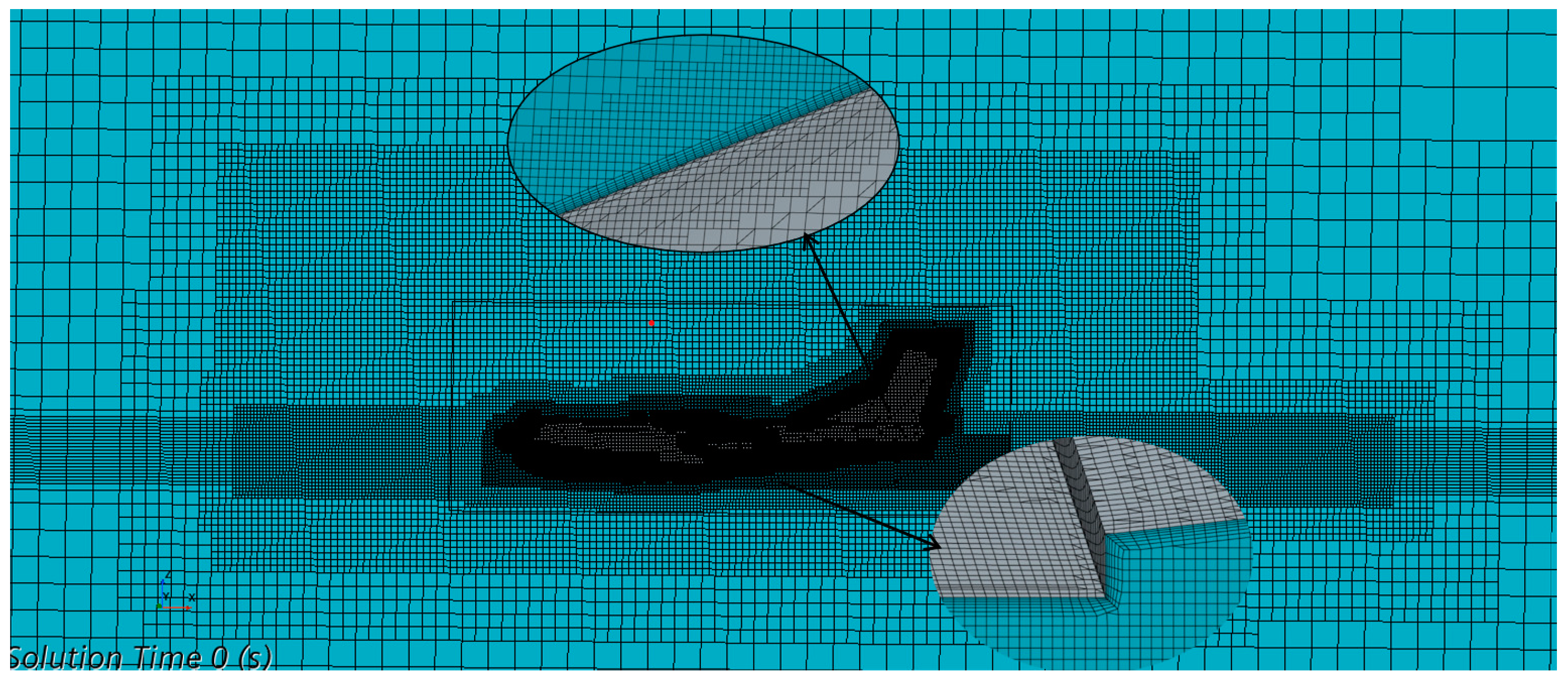





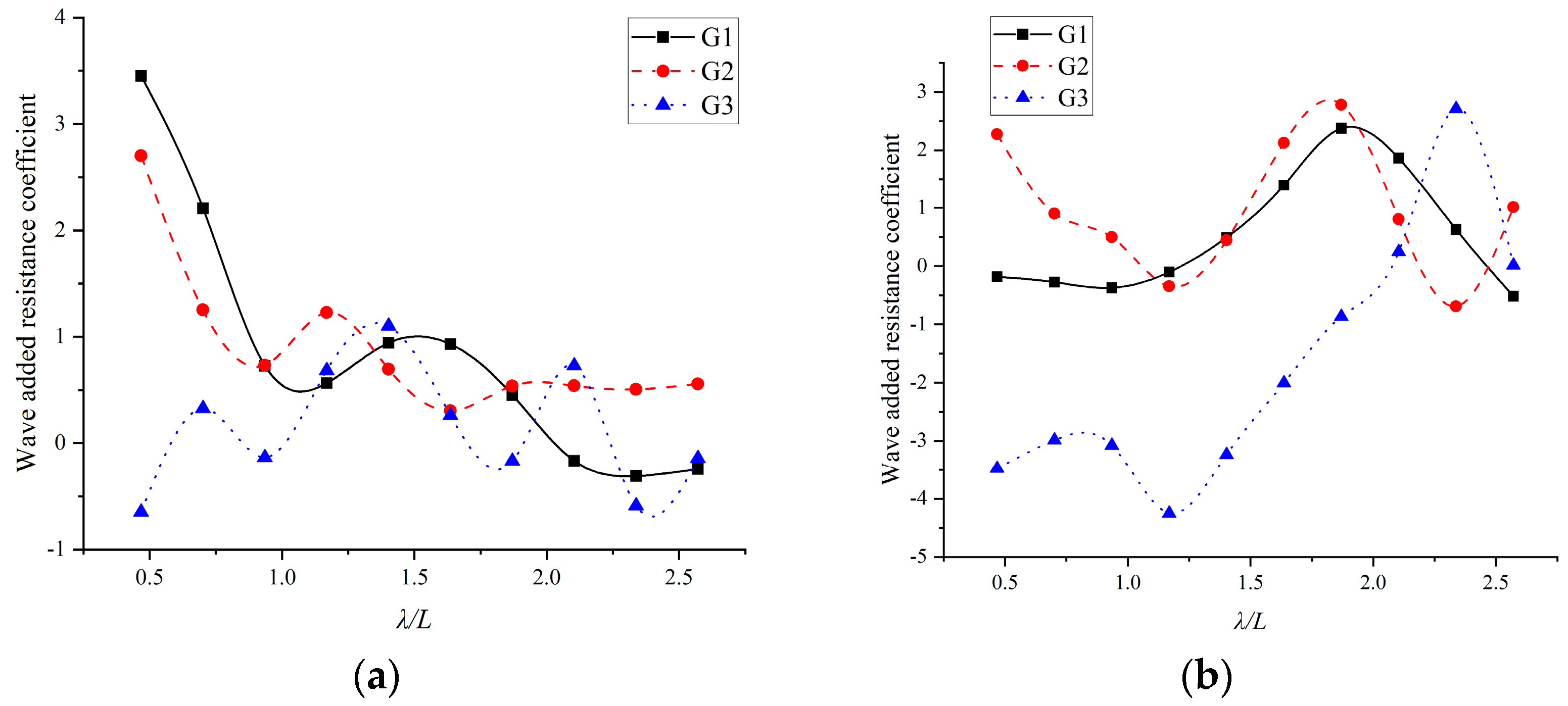
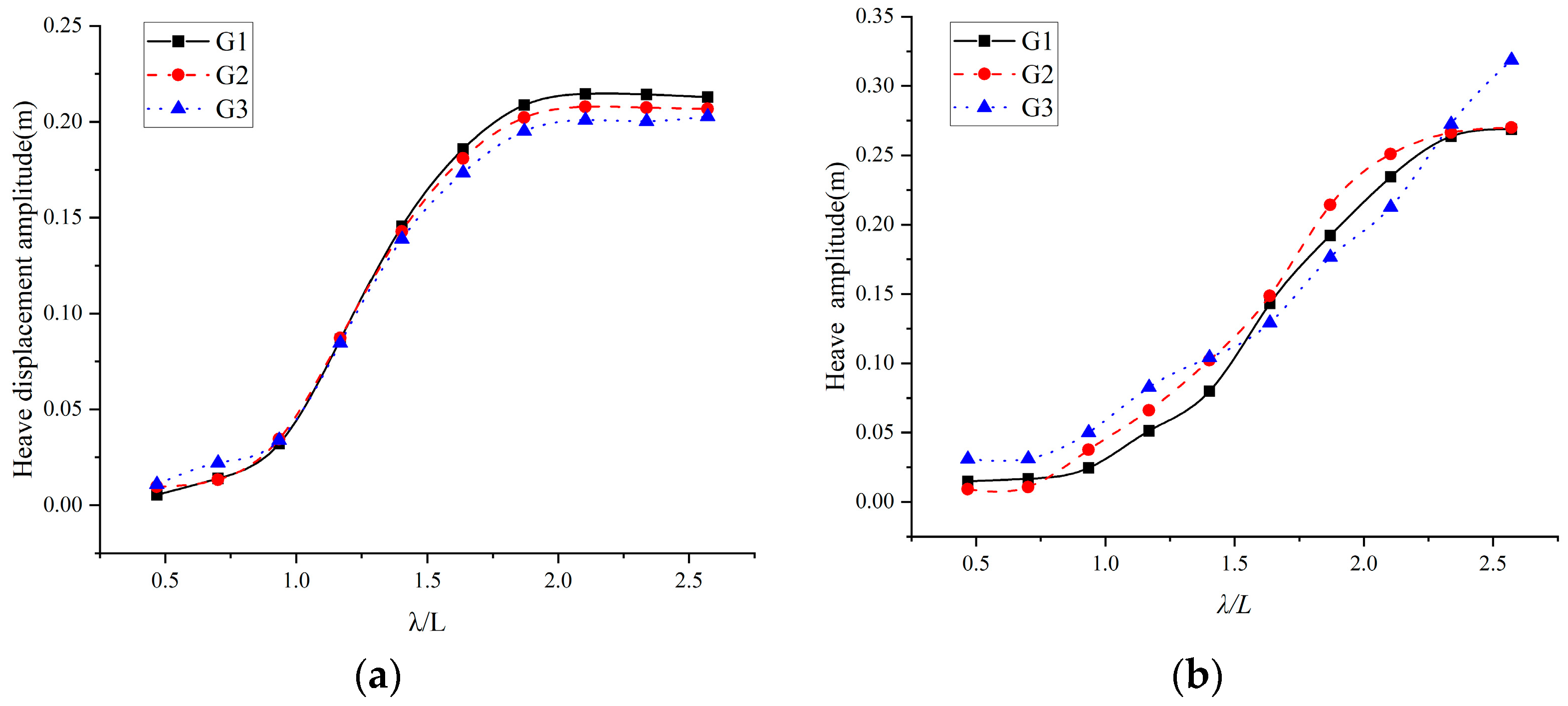
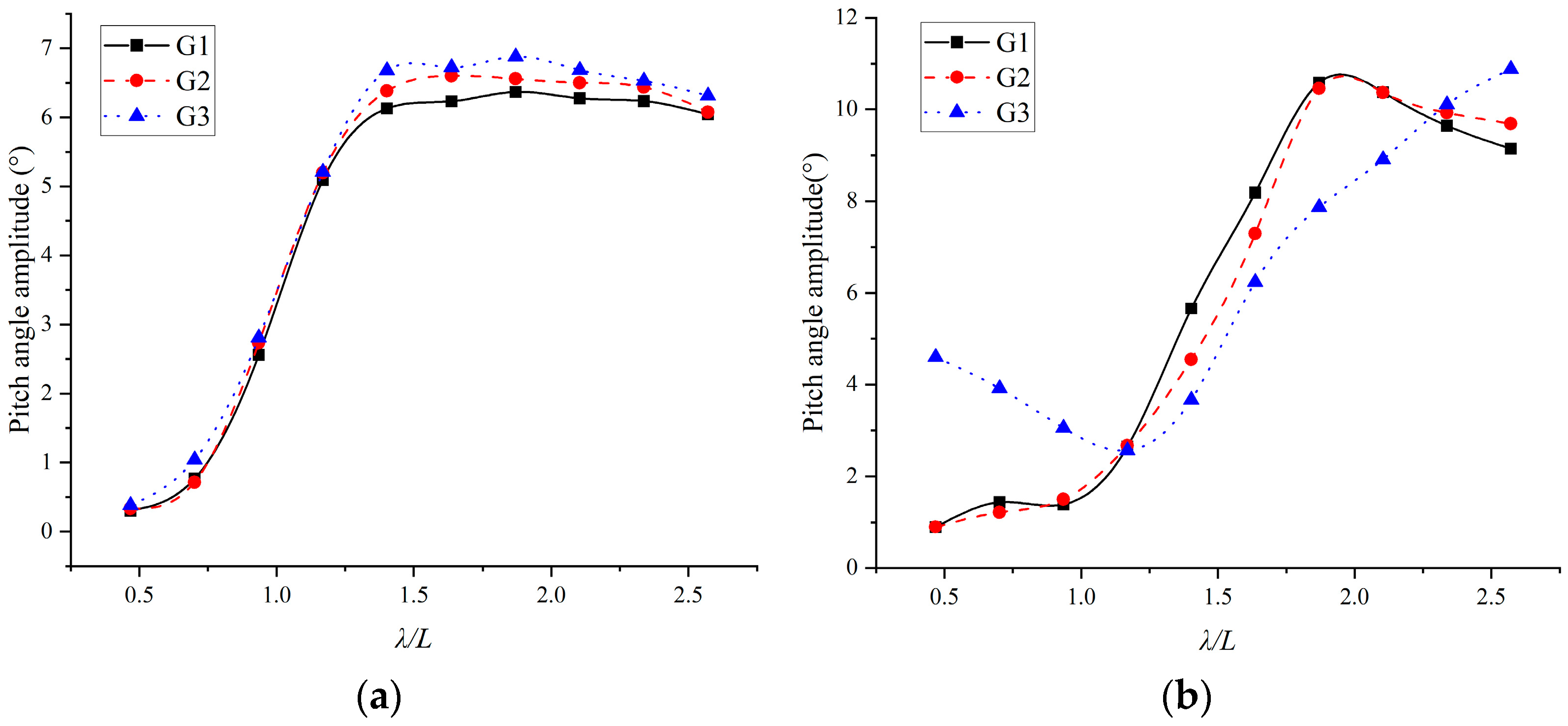




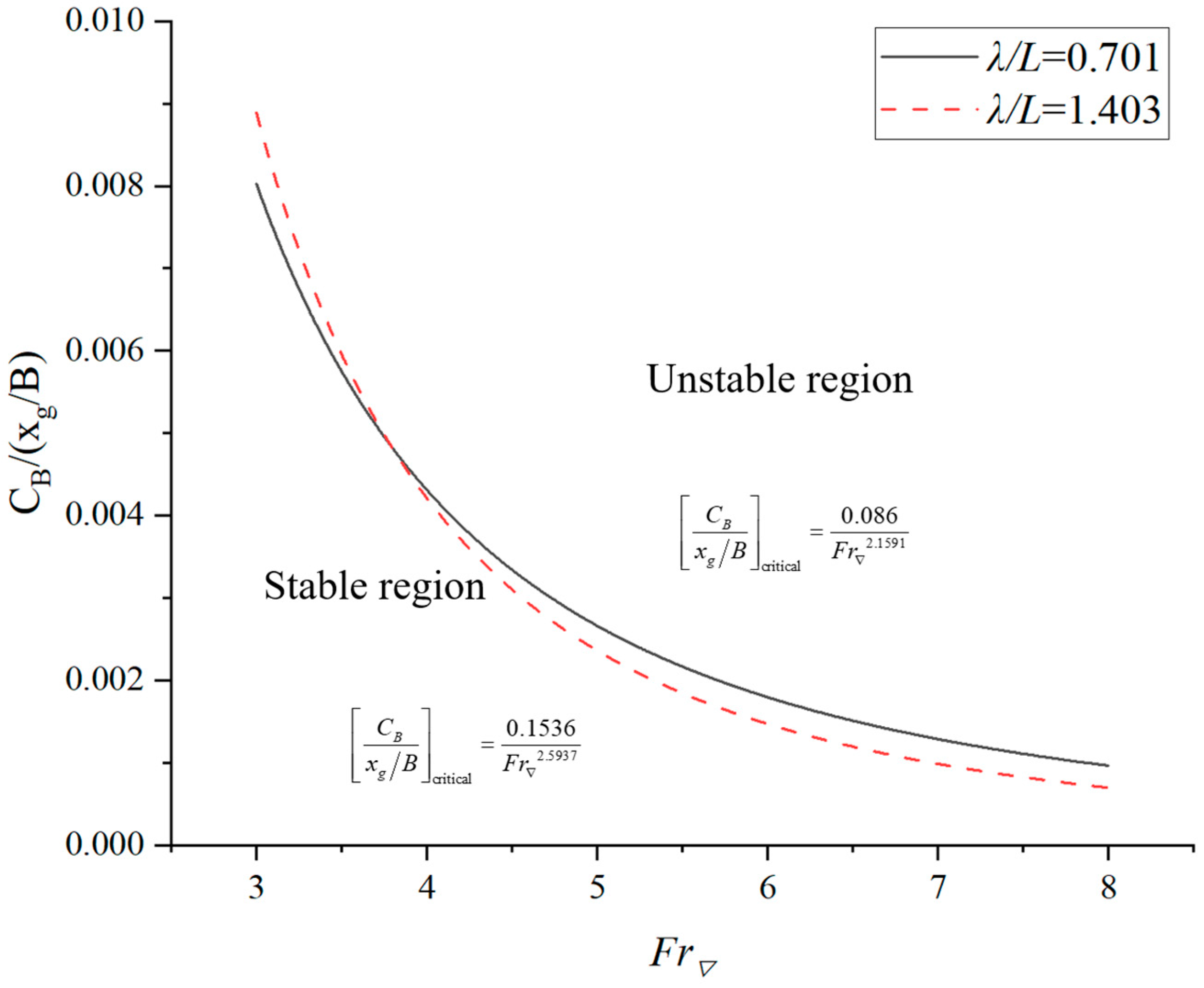
| Fuselage Length/m | Wingspan/m | Wing Area/m2 | Weight/kg | Planing Step Height/m |
|---|---|---|---|---|
| 4.278 | 4.56 | 1.75 | 87.12 | 0.23 |
| Deadrise angle/° | Beam/m | Draft/m | Flap deflection/° | Rudder deflection/° |
| 22 | 0.38 | 0.185 | 45 | 0 |
| Grid Refinement Schemes | Grid Refinement Schemes for the Region of Free Surface | Grid Refinement Schemes for the Force Components | Grid Size |
|---|---|---|---|
| Coarse grid | 15‰L | 7.5‰L | 6.53 million |
| Medium grid | 7.5‰L | 3.75‰L | 8.25 million |
| Fine grid | 3.75‰L | 1.875‰L | 14.36 million |
| Test Values | Coarse Grid | Deviation (%) | Medium Grid | Deviation (%) | Fine Grid | Deviation (%) | |
|---|---|---|---|---|---|---|---|
| Resistance (N) | 195.910 | 171.534 | 12.440 | 185.822 | 5.150 | 189.200 | 3.430 |
| Pitch angle (°) | 8.700 | 7.911 | 9.070 | 8.273 | 4.910 | 8.430 | 3.100 |
| Heave (m) | 140.000 | 145.689 | −4.060 | 142.304 | −1.650 | 141.110 | −0.790 |
| Test Values | t = 0.001 s | Deviation (%) | t = 0.002 s | Deviation (%) | t = 0.003 s | Deviation (%) | |
|---|---|---|---|---|---|---|---|
| Resistance (N) | 195.91 | 190.822 | 2.60 | 189.078 | 3.49 | 188.19 | 3.94 |
| Pitch angle (°) | 8.7 | 8.573 | 1.46 | 8.564 | 1.56 | 8.396 | 3.49 |
| Heave (mm) | 140 | 140.704 | −0.50 | 141.358 | −0.97 | 141.634 | 1.17 |
| Test values | t = 0.004 s | Deviation (%) | t = 0.007 s | Deviation (%) | t = 0.01 s | Deviation( %) | |
| Resistance (N) | 195.91 | 185.822 | 5.15 | 177.334 | 9.48 | 162.9 | 16.85 |
| Pitch angle (°) | 8.7 | 8.273 | 4.91 | 7.95 | 8.62 | 7.446 | 14.41 |
| Heave (mm) | 140 | 142.304 | 1.65 | 143.91 | 2.79 | 144.85 | 3.46 |
| λ/L = 0.701 | λ/L = 1.403 | |||||
|---|---|---|---|---|---|---|
| xg/m | 1.908 | 2.015 | 2.122 | 1.908 | 2.015 | 2.122 |
| v1/(m·s−1) | 9 | 15 | 15 | 9 | 8 | 14 |
| v2/(m·s−1) | 10 | 16 | 16 | 10 | 9 | 15 |
| CB1/(xg/B) | 0.003494 | 0.001191 | 0.001131 | 0.003494 | 0.004187 | 0.001298 |
| CB2/(xg/B) | 0.002830 | 0.001046 | 0.000994 | 0.002830 | 0.003309 | 0.001131 |
Disclaimer/Publisher’s Note: The statements, opinions and data contained in all publications are solely those of the individual author(s) and contributor(s) and not of MDPI and/or the editor(s). MDPI and/or the editor(s) disclaim responsibility for any injury to people or property resulting from any ideas, methods, instructions or products referred to in the content. |
© 2024 by the authors. Licensee MDPI, Basel, Switzerland. This article is an open access article distributed under the terms and conditions of the Creative Commons Attribution (CC BY) license (https://creativecommons.org/licenses/by/4.0/).
Share and Cite
Sun, H.; Ju, A.; Chang, W.; Liu, J.; Liu, J.; Sun, H. Research on Wave-Added Resistance and Longitudinal Stability Characteristics of Amphibious Aircraft in Rule Wave. J. Mar. Sci. Eng. 2024, 12, 585. https://doi.org/10.3390/jmse12040585
Sun H, Ju A, Chang W, Liu J, Liu J, Sun H. Research on Wave-Added Resistance and Longitudinal Stability Characteristics of Amphibious Aircraft in Rule Wave. Journal of Marine Science and Engineering. 2024; 12(4):585. https://doi.org/10.3390/jmse12040585
Chicago/Turabian StyleSun, Huawei, Anran Ju, Wentian Chang, Jingfei Liu, Jiayi Liu, and Hanbing Sun. 2024. "Research on Wave-Added Resistance and Longitudinal Stability Characteristics of Amphibious Aircraft in Rule Wave" Journal of Marine Science and Engineering 12, no. 4: 585. https://doi.org/10.3390/jmse12040585
APA StyleSun, H., Ju, A., Chang, W., Liu, J., Liu, J., & Sun, H. (2024). Research on Wave-Added Resistance and Longitudinal Stability Characteristics of Amphibious Aircraft in Rule Wave. Journal of Marine Science and Engineering, 12(4), 585. https://doi.org/10.3390/jmse12040585





